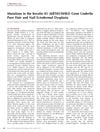11 citations
,
July 2010 in “European Journal of Dermatology” The condition is linked to chromosome 12, but no mutations were found in the known genes.
 42 citations
,
October 2009 in “The journal of investigative dermatology/Journal of investigative dermatology”
42 citations
,
October 2009 in “The journal of investigative dermatology/Journal of investigative dermatology” Mutations in the KRT85 gene cause hair and nail problems.
189 citations
,
July 2009 in “The Journal of clinical investigation/The journal of clinical investigation” Epidermolysis bullosa simplex causes easily blistered skin due to faulty skin cell proteins, leading to new treatment ideas.
79 citations
,
February 2009 in “Human Genetics” 6 citations
,
January 2008 in “Indian Journal of Dermatology” Monilethrix, a genetic hair disorder causing fragile hair, affects three generations in a family.
138 citations
,
March 2007 in “Experimental cell research” Only a few hair-specific keratins are linked to inherited hair disorders.
 788 citations
,
February 2007 in “Nature”
788 citations
,
February 2007 in “Nature” The document concludes that skin stem cells are important for hair growth and wound healing, and could be used in regenerative medicine.
97 citations
,
March 2006 in “Journal of Investigative Dermatology” 60 citations
,
March 2006 in “Journal of Medical Genetics”  74 citations
,
January 2006 in “The journal of investigative dermatology/Journal of investigative dermatology”
74 citations
,
January 2006 in “The journal of investigative dermatology/Journal of investigative dermatology” Mutations in the DSG4 gene can cause a rare hair disorder similar to monilethrix.
79 citations
,
March 2005 in “Journal of Medical Genetics” 276 citations
,
January 2005 in “International review of cytology” 110 citations
,
August 2004 in “British Journal of Dermatology” The ventral matrix is the main source of the nail plate.
88 citations
,
March 2004 in “Journal of Investigative Dermatology” 272 citations
,
September 2001 in “Journal of Biological Chemistry” Human hair keratins were cataloged, showing their roles in hair differentiation stages.
130 citations
,
April 2001 in “Journal of Investigative Dermatology” 119 citations
,
January 2000 in “British Journal of Dermatology” The study examined keratin expression in the nail unit using antikeratin monoclonal antibodies, revealing distinct patterns of differentiation. The nail matrix uniquely expressed the acidic hair-type keratin Ha1, alongside epidermal keratins K1 and K10, with occasional K17 at the matrix apex. K6 and K16 were present at the ventral aspect of the proximal nail fold. The nail bed lacked Ha1 and markers of cornified and mucosal differentiation but contained K6, K16, and K17, indicating minimal differentiation due to the nail's properties. In the digit pulp, K6, K16, and K17 were found in limited amounts, possibly linked to the eccrine duct's epidermal component. Simple epithelial keratins K7, K8, and K18 were present in younger individuals, mainly in epibasal cells and putative Merkel cells.
32 citations
,
January 2000 in “Human Heredity” Monilethrix, a rare autosomal dominant hair disorder, was studied in 12 families and sporadic cases, focusing on mutations in the helix termination motif of keratin hHb6. Mutations were found in 6 families, with 4 families exhibiting known mutations (Glu413Lys and Glu413Asp) and 2 families showing a novel mutation (Glu402Lys). The study found no clear link between mutation type and disease severity, as heterozygous family members displayed varying symptoms, while homozygous individuals in a consanguineous family were more severely affected. This suggested that other genetic or environmental factors might influence the condition.
175 citations
,
September 1998 in “British Journal of Dermatology” The study identified that mutations in the keratin 17 (K17) gene were responsible for both pachyonychia congenita type 2 (PC-2) and steatocystoma multiplex, with the phenotypic outcome being independent of the specific mutation. Three unrelated families with K17 mutations were examined, revealing that two families shared the same missense mutation (R94C) but exhibited different phenotypes: one with classical PC-2 features and the other with steatocystoma multiplex. A third family with PC-2 had a different mutation (N92S). The research highlighted that K17 mutations were a common underlying cause for both conditions, expanding the known distinct mutations in K17 to 11.
175 citations
,
August 1997 in “Nature Genetics” 232 citations
,
July 1995 in “Nature Genetics” 277 citations
,
October 1982 in “The Journal of Cell Biology”


